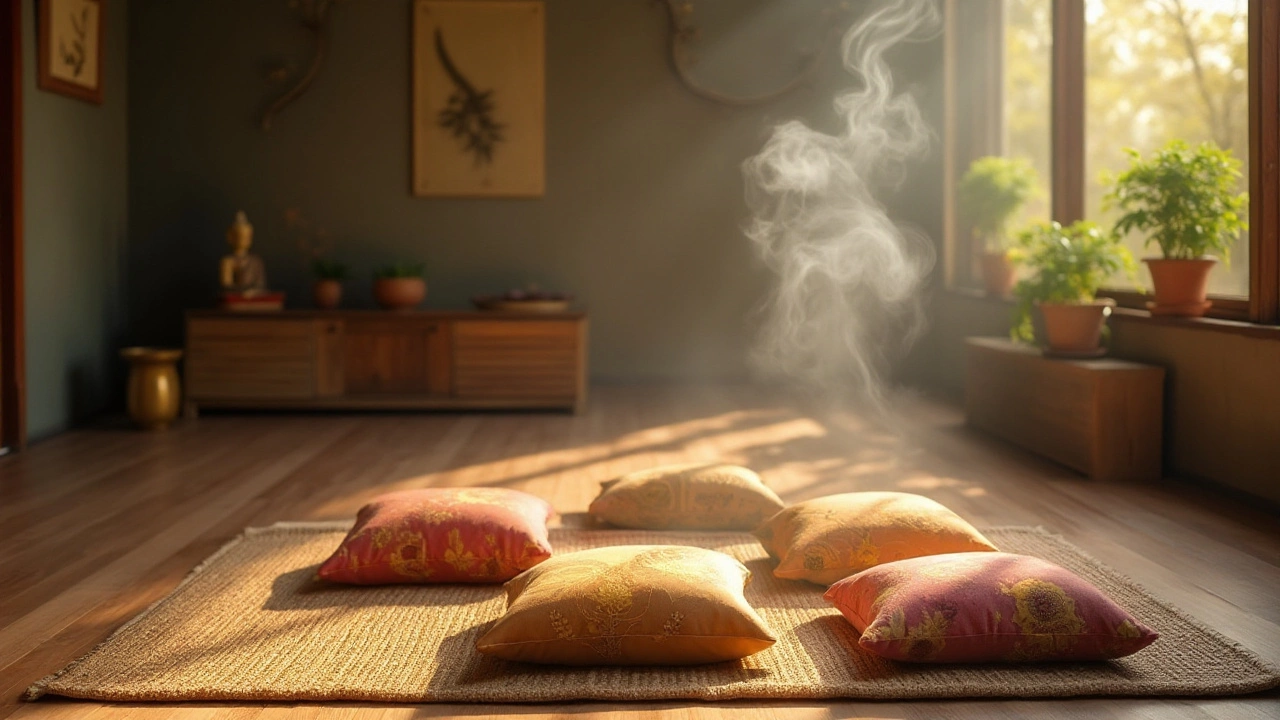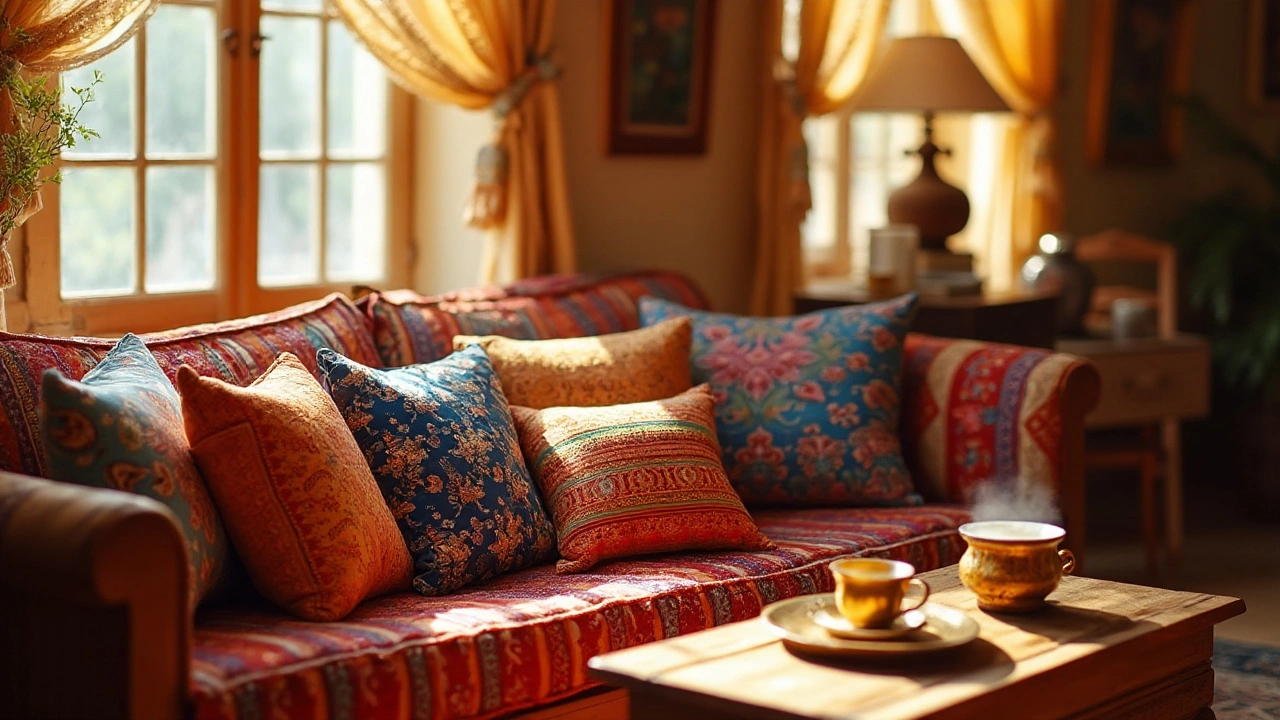Cushions, those plush companions found on sofas, beds, and a variety of seating arrangements, enrich our living spaces with comfort and style. These delightful objects are not only ubiquitous in homes but also have a fascinating history and a variety of names depending on where you find yourself in the world.
Whether you're sinking into a soft pile of pillows after a long day or using them to enliven your living room decor, cushions bring both function and flair to the space they inhabit.
In this article, we'll explore the different ways cushions are named and used globally, examine the types and materials of cushions available, and share tips for choosing and caring for these essential decor elements. Get cozy and join us on a journey through the world of cushions!
- The Origins of Cushions
- Cultural Names for Cushions
- Different Types of Cushions
- Materials Matter: Choosing the Right Fabric
- Cushions in Modern Decor
- Tips for Choosing and Maintaining Cushions
The Origins of Cushions
While the cushion might seem like a modern convenience, its history is long and varied. Ancient civilizations appreciated the comfort and aesthetic value of such items long before today's sprawling couch cushions became ubiquitous. The Egyptians, known for their opulence and innovation, are believed to have used the earliest forms of cushions. These ancient Egyptians often employed cushions in their seating arrangements to reflect status and comfort. Only the wealthy could afford to have these cushioned seats available due to the expense of their elaborate construction, often involving rare and luxurious fabrics.
As you move into the time of the Greeks and Romans, cushions began to be more commonplace, adorning the homes of the affluent and making public spaces more inviting. These ancient cultures were notably fond of showcasing opulence, and cushions played a role in their displays of luxury. Roman banquets, for example, utilized a specialized dining practice known as 'triclinium,' where guests would lounge on couches or benches padded generously with cushions while enjoying their feasts. This setup highlighted the social importance of dining, and the use of cushions was integral to the comfort and status of the occasion.
Historical records, such as those by the Greek historian Herodotus, give us insights into how cushions and other luxuries decorated the living spaces of ancient nobility. Herodotus emphasized their significance by saying, "The wealth of a man is his measure, yet comfort lies not in gold alone but in the repose his home affords."
In the medieval period, cushions made their way into the households of European aristocracy. During this era, cushions were often filled with feathers and covered in velvets and silks, materials that were hard to obtain by common folk. This transition marks the spread of cushions from being a luxury to an accessible item among the non-noble classes over time. As trade routes expanded across continents, the exchange of textiles and ideas enabled a broader spectrum of people to own cushions.
Interestingly, the Industrial Revolution further democratized cushion accessibility. With the advent of machine production, the time-consuming process of hand-sewing cushions was expedited, making it feasible to produce them at a lower cost. Innovations in the textile industry introduced materials like cotton and upholstery techniques that are not only durable but also more affordable and varied. Consequently, by the 19th century, households from different economic backgrounds could enjoy the comfort cushions provided. Can you imagine a world without cushions now?
The journey of the cushion from a select item to a universally recognized household staple is quite telling of societal shifts across time and geography. Today, they serve multifaceted purposes in modern decor, merging seamlessly into the design fabric of contemporary spaces. The cushion's story is intertwined with our own evolution as cultures have shared, adapted, and innovated upon this simple yet impactful concept of comfort and decoration.
Cultural Names for Cushions
The world is a tapestry of cultural richness, and this diversity is reflected in the variety of names used for something as simple as a cushion. Across continents and languages, the terminology changes, often offering fascinating glimpses into the cultural significance and use of these everyday items. Each term carries with it a unique story, illustrating how intertwined these objects are with our day-to-day lives.
In Japan, cushions are referred to as 'zabuton'. These traditional thin cushions are typically used in homes and temples, placed on tatami floors. They serve both comfort and ceremonial purposes, embodying the Japanese appreciation for minimalism and functionality. Meanwhile, in the Middle East, you might hear the word 'makad'. Derived from the Arabic root meaning 'to sit', a makad is often a plump, decorative cushion providing both support and vibrant decor to the bustling majlises of Arabian homes.
Europe brings its own diversity to cushion naming conventions. In France, one could hear the elegant term 'coussin', whereas in Italy, they are familiarly known as 'cuscino'. These words not only refer to the often flamboyant and stylish cushions seen throughout Europe's famously chic interiors but also reveal a historical penchant for combining aesthetic with comfort.
A design historian once noted, "The evolution of cushion names is a reflection of their journey through different civilizations, each adapting them to suit their lifestyle and sense of beauty."
In South Asia, specifically India, the word 'gaddi' is often used, depicting cushions that are typically more quilted and colorful, holding significant cultural symbolism during festivals and traditional ceremonies. Meanwhile, in African cultures, the variety in cushion names and designs can be as diverse as the communities themselves, often influenced by local languages and traditions. In Nigeria, decorative pillows known as 'balawo' are commonly used in interior décor, playing dual roles in comfort and craftsmanship.
The global names for cushions not only tell stories of linguistic diversity but also highlight the small yet meaningful roles these items play in everyday life. They provide a comfort that is universally recognized, a beauty that is locally inspired, and an adaptability that speaks to the interconnectedness of human creativity.

Different Types of Cushions
When it comes to the realm of cushions, variety truly is the spice of life. Each type serves a unique purpose, offering just the right touch of elegance or ease required in different settings. Let's take a closer look at the myriad forms these delightful pillows take, each with its distinct characteristics and charm.
Seat cushions are designed specifically to make your sitting experience more comfortable. Found in dining rooms, backyard patios, and even on the office chair, these cushions deliver both support and a splash of style. Their density and thickness vary widely, with options available for nearly every ergonomic need and personal taste.
Then there's the classic throw cushion, a staple in living rooms across the globe. These versatile pieces of decor aren't just about aesthetics, though their ability to introduce color and pattern should never be underestimated. They also provide back support on sofas or additional seating when unexpected guests arrive.
"The living room is a uniquely special place where expression of style through cushions truly takes off." —Interior Design Magazine
Floor cushions, on the other hand, have soared in popularity in recent years, thanks to their blend of comfort and a casual vibe. Ideal for relaxed gatherings or meditation spaces, these oversized cushions invite you to sit right on the floor without a care in the world.
The world of cushions also presents us with lumbar and neck support options, which are particularly beneficial for those who prioritize wellness. These cushions often feature contoured designs and are made from materials like memory foam, which can cradle the spine or neck, offering relief and relaxation when you need it most.
Some people discover delight in more specialized cushion types, such as those designed specifically for the outdoors. These are typically water and mildew-resistant, often made from fade-proof materials to withstand the elements, so your garden or balcony remains vibrant with little effort.
For those looking for a practical approach, multifunctional cushions can be an exciting discovery. Think of poufs that double as storage units or cushions that can be linked together to form a makeshift bed — ingenuity at its finest!
Whether it's the need for a fashionable accent on the couch or a practical accessory for better posture, cushions continue to be indispensable. Each type serves a wonderful purpose, melding seamlessly into our daily lives.
Materials Matter: Choosing the Right Fabric
When it comes to selecting the perfect cushions for your home, the choice of fabric is as important as, if not more than, the cushion's design or color. The material of your cushions not only affects their appearance but also has a significant impact on their functionality, durability, and maintenance requirements. Whether you're aiming for a plush, luxurious feel or a sturdy, everyday practicality, understanding different fabrics can guide you to make the best choice for your living space.
Cotton, for instance, is one of the most popular fabrics for cushions due to its softness, breathability, and ease of care. It's available in countless colors and patterns, making it easy to match with various decor styles. More often than not, you’ll find cotton cushions perfectly paired with floral prints, enhancing a cozy and inviting atmosphere. On the other hand, if durability and resistance to stains are your top priorities, fabrics like polyester and acrylic might be more suitable. These synthetic materials are known for their resilience to wear and tear, and they often come with the added benefit of being fade-resistant, which is particularly valuable if your cushions are exposed to direct sunlight.
"Fabric choice isn't just about aesthetics—it's a practical decision that affects the cushion's lifespan and the comfort it provides," says interior designer Lila Thompson.
Now, let's talk about more luxurious materials that can elevate your cushion collection. Velvet, for example, delivers an opulent touch to any room with its rich texture and depth of color. However, it may require more mindful care to maintain its lush appearance over time. Similarly, silk offers unrivaled elegance, but due to its delicate nature, it's best used in adult-only spaces or special occasions where less frequent use can preserve its beauty. For more environmentally conscious options, fabrics like organic cotton or bamboo are gaining popularity. These not only reduce environmental impact but also bring natural benefits such as hypoallergenic properties and antibacterial qualities. When selecting fabric, considering the room where the cushions will be used—whether it's a busy family room or a serene bedroom—can aid you in making an informed decision.
If you’re looking for added flair, you might want to explore cushion covers that incorporate embellishments like embroidery or sequins. Fabrics like linen could serve as an excellent base for these details, offering a rustic charm and durability. However, keep in mind that such decorative elements could complicate cleaning. For those preferring low maintenance, opting for removable cushion covers with zipper closures can be beneficial. They allow for easy washing, which is especially convenient for homes with children or pets. This brings us to the next critical consideration: whether the fabric is machine washable or requires dry cleaning can save a lot of time, effort, and potential replacement costs in the long run. By pondering these factors, selecting the right cushion material becomes a careful balance of style, function, and ease-of-care, ensuring that your cushions are not just beautiful but also aligned with your lifestyle needs.

Cushions in Modern Decor
In contemporary interior design, cushions have transcended their mere functional origins to become pivotal elements of style and personal expression. They are no longer just about comfort; they are a key visual component in composing the aesthetics of a room. With the myriad of colors, patterns, and materials available, cushions are the perfect way to explore trends and infuse vibrant life into a space without committing to a permanent change. The beauty of cushions lies in their versatility, allowing for seasonal updates and quick swaps to refresh a room's look entirely.
Interior designers often suggest utilizing cushions to experiment with bold colors or intricate patterns you might hesitate to try on larger items, like sofas or walls. A brightly colored pillow can act as a focal point within a neutral palette, creating visual interest that draws the eye. Varied shapes and sizes, from small accent cushions to larger bolster pillows, contribute to layering in texture and dimension. This can transform a simple sitting area into a dynamic and inviting nook.
The textile innovation in cushion covers offers not just aesthetic variety but also practicality. Washable materials such as cotton blends and modern fabric technologies like microfiber provide ease of maintenance without sacrificing style. These choices, especially in homes with children or pets, marry style with sensible living. Sustainability has also become a focus with eco-friendly fabrics—such as organic cotton and recycled textiles—becoming increasingly popular. This trend responds to growing awareness around environmental conservation, ensuring that a desire for vibrant decor doesn't compromise the planet.
The strategic placement of cushions can subtly guide the flow of a room. Consider a sophisticated arrangement on a large sectional sofa or a quaint cluster of mixed textures in a window seat. To dive deeper into the evolving role of cushions, it's worth noting the thoughts of experts like interior designer Sarah Richardson, who stated, "Cushions are the simplest way to rejuvenate a room and update it on a budget."
By carefully selecting cushion styles that reflect personal taste, individuals can personalize a room effortlessly, reflecting personality and comfort.
Moreover, for those who love to entertain, cushions can set the tone for conversations and gatherings, providing both comfort and talking points through unique designs and interesting textures. Outdoor cushions have also claimed their spot in exterior decor, with weather-resistant fabrics ensuring that patios and gardens maintain their allure throughout the seasons. Regardless of the setting, cushions provide a canvas for creativity and comfort, enhancing any environment they grace.
Tips for Choosing and Maintaining Cushions
When it comes to selecting the perfect cushions for your home, the choices can be overwhelming. But fear not, as this section will guide you through the crucial aspects of making that perfect pick, ensuring they look great and last long! First, consider the function. Is it for a decorative touch or for practical back support while binge-watching your favorite series? Identifying the primary purpose helps narrow the choices. Then think about the style and color. Cushions can either complement your existing decor or serve as bold accent pieces that draw attention. For a cohesive look, pick shades that match or harmonize with the surrounding colors or patterns in your space.
Next, dive into the world of materials. Whether you are drawn to the elegance of silk or the durability of cotton, the fabric you choose will play a pivotal role in its longevity and maintenance demands. Cotton and linen are excellent for family-friendly environments due to their ease of cleaning and durability. On the other hand, if luxury is more your style, velvet cushions provide a plush texture that exudes opulence. But remember, they might need a bit more care. Consider how much wear and tear they might experience daily. Does anyone in your household have allergies? If so, hypoallergenic materials like linen could be favorable.
Maintaining Your Cushions
Now, onto the art of keeping them in tip-top shape. Start with a regular cleaning routine. Most cushion covers are removable and machine-washable, making it easier to keep them fresh. Vacuuming your cushions weekly can prevent dust accumulation and prolong their lifespan by maintaining the plushness of the filling. When washing, adhere to care instructions; using cold water and mild detergent preserves the fabric's color and texture longer. Also, rotate your cushions every so often to ensure even wear, somewhat like flipping a mattress.
"Cushions can breathe new life into any decor setting, offering one of the easiest ways to refresh a room for the season or your mood," says renowned interior designer Jane Michaels. "But maintaining them well is crucial for that instant uplift effect."
Every once in a while, take the time to fluff them up. This simple act helps maintain their shape and supports overall comfort. Poking and prodding cushions back into their true form not only adds to their appearance but also improves their longevity. For particularly cherished pieces, consider storing them away from direct sunlight and moisture, especially with delicate fabrics. Lastly, while redesigning your decor, consult your cushions' diverse shapes and sizes to create visual interest and depth on a couch or bed.
